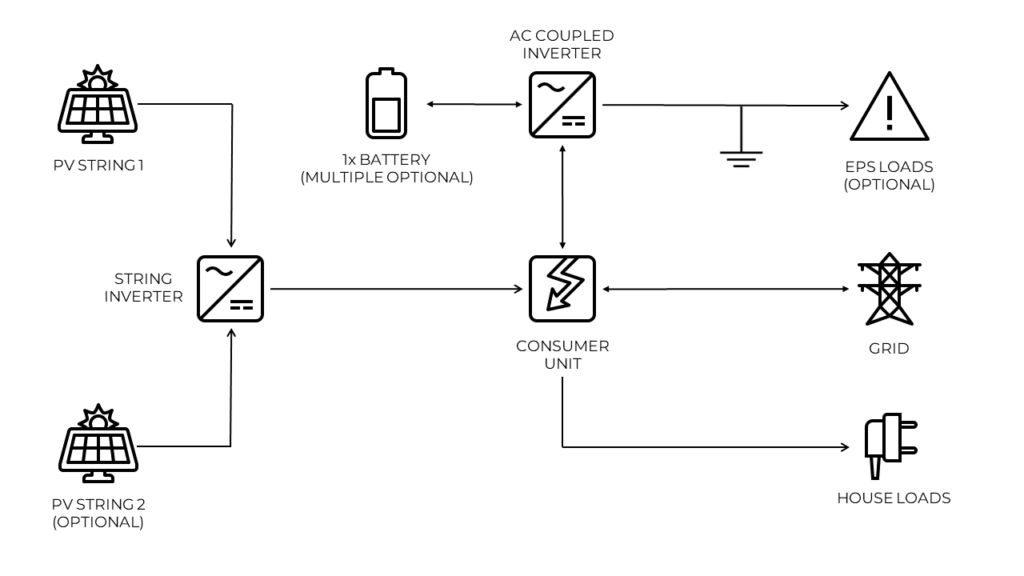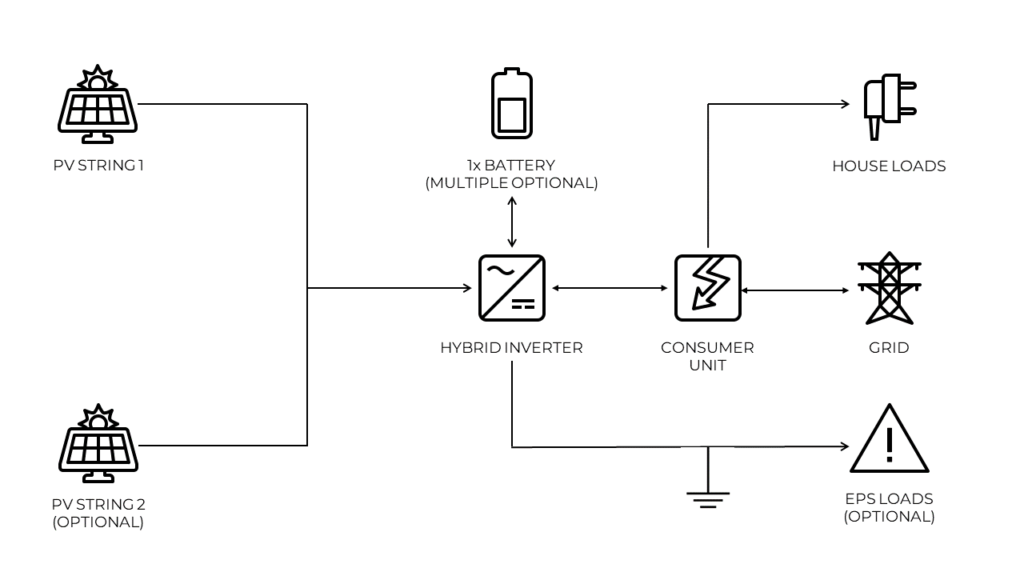System Arrangements #
There are several different ways to connect up your PV system depending on what you are trying to achieve & also what you already have installed.
The most common setups are noted below.
String Inverter #

The most basic system. No Battery at all. Solar panels are connected to a string inverter which converts the DC from the solar panels into 230V AC. This is fed into your house consumer unit where any house load is covered and any excess is exported straight to the grid.
You cannot store the generated energy for later and therefore you do rely on consuming as much as possible while the sun is shining.
These are usually the cheapest route to get PV into your home.
It should be noted that Givenergy do not offer any String Inverters so this would be a different brand of Inverter.
AC Coupled System #

This is a similar setup to the “String” inverter but with the addition of a second Inverter which controls the flow of excess energy to a battery.
It does this by monitoring the grid supply to the house, checking for when the PV system is exporting power to the grid. In this condition the AC Coupled Inverter will begin charging the battery at a rate as high as possible without causing the export power to drop below 0.
Similarly it also works in reverse, so if you are importing power say at night, the AC Coupled Inverter will discharge the battery up to a power level where you are no longer importing from the grid.
This maximises the amount of energy you can store for later & is a common route for those with existing PV arrays that did not originally have battery storage installed.
It also allows you to charge up the battery on cheaper overnight tariffs if that is available to you.
It should be noted that the term “AC Coupled” is derived from the fact that the Battery Inverter is not directly connected to the PV panels at all. It is instead indirectly connected to the panels via the 230V mains house supply on a separate MCB in the consumer unit, hence the term “AC Coupled”.
This route is very popular with those on FIT schemes as it allows you to add Battery Storage capability to your existing system without interfering with your FIT payments (as the connection can be made after the FIT metering point.)
Hybrid System #

This system is basically combining both a normal String Inverter & a battery charger into one box.
The PV Panels are connected directly to the Hybrid Inverter which has the ability to split power to either the 230V AC side to the house or the inbuilt Battery Charger at the same time. As the battery is already DC this improves efficiency over the AC Coupled systems as it does not suffer the same conversion losses: going from PV Panel (DC) to AC (House Power) & then converting back to DC (via an AC Coupled Inverter))
Another benefit is that if your PV array is big enough you can actually harvest more energy than you otherwise would with a String Inverter of the same capacity. This is because you can essentially max out the AC converter side whilst also charging batteries at the same time: i.e. on a 5kW Givenergy Hybrid you could have 6.5kW of PV being distributed as 5kW to AC with the remaining 1.5kW being sent to the battery all at once.
Beware though this doesn’t work the other way – you are ultimately limited to 5kW of usable 230V AC power to the house from the 5kW Hybrid – either from PV, Battery or a mix of the two!
These systems are most commonly used for new installations as they combine numerous separate inverters & chargers into one neat box (which also means you also only need 1 app to control everything.)
Similar to the AC Coupled System you can also charge the battery over night from the Grid supply to use the following day if you have a tariff that offers lower overnight costs.
Multiple Batteries #
Most systems allow you to add multiple batteries to their inverters to increase Energy storage capacity (kWh). All makes of inverter will however have a maximum number that can be added.
Beware that adding multiple batteries may not boost charging or discharging rates (See Also: Batteries) – it often only changes the TOTAL AMOUNT of energy you can store (kWh not kW).
Just beware of this if you are basing your system on charging using cheap overnight power – make sure that you can actually push enough into the batteries in the time window given by checking the inverters maximum charge rate!
For Givenergy Inverters the maximum number of batteries per inverter is 5. They can be mixed capacities although the largest of the chain should be the first in the line. (Your installer should sort all this.)
(See also: Batteries)
Plant / Multiple Inverter Systems #
To further improve the power output of the system you can also add multiple AC Coupled Inverters together in the same house. This is called a plant system and in theory they should work “as one” to provide more power to the house. (i.e. 2x 3kW Inverters allows 6kW of battery charge & discharge capability)
Currently (11/08/22) this type of setup has some issues (not staying in sync with each other or one discharging into the other) therefore you need to be aware of this if you go down this route.
Although Givenergy are currently working on a fix for it, it is not yet ready.
Multiple Hybrids are not recommended – however some have had success so I’m unsure as to the reason why.




